As an Amazon Associate, we earn from qualifying purchases. We may also earn commissions if you purchase products from other retailers after clicking on a link from our site.
You know that sinking feeling you get when your car breaks down, and you’re stranded in the rain? In such incidents, your first thought may be to try and jumpstart the vehicle. But can you jump a car in the rain?
You can jump a car in the rain. A car’s battery is typically 12 volts, which is safe to handle in wet conditions. However, it’s important to take safety precautions and follow proper procedures when jumpstarting the car, such as using insulated jumper cables and keeping your hands and clothing dry.
In this post, I’ll explain why it’s safe to jumpstart a car in the rain. I’ll also provide some tips for staying safe while jumping your vehicle. If that’s what you’re looking for, keep reading to learn more!
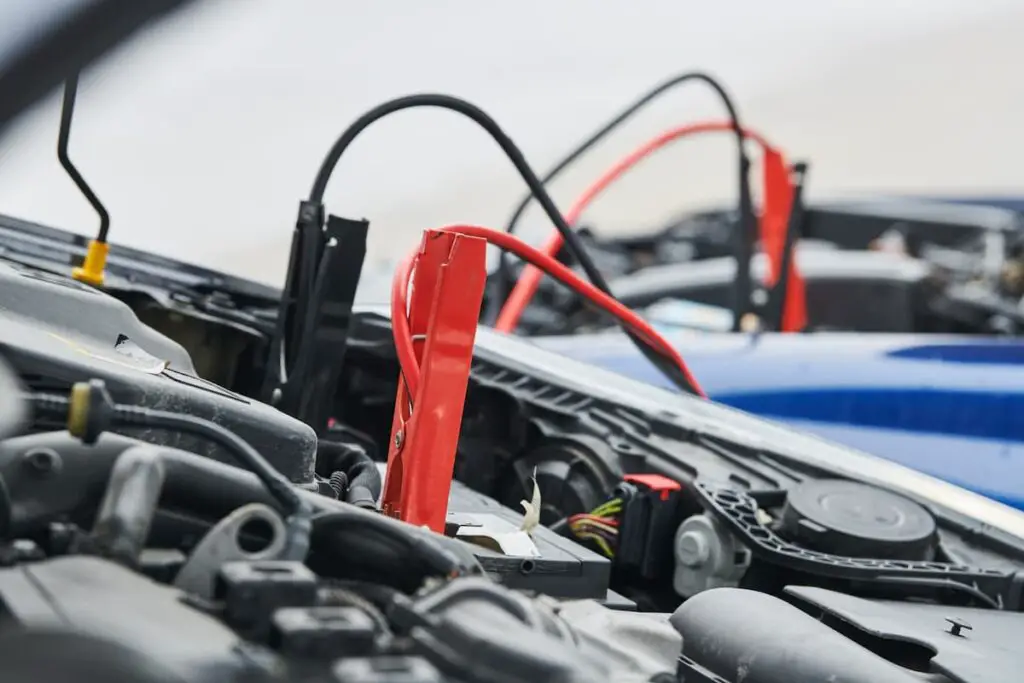
Is Jumpstarting a Car in the Rain Dangerous?
Many people believe that jumpstarting a car in the rain is dangerous, but it’s not necessarily true. While you may electrocute yourself if you are not careful, the risk is relatively low as long as you take precautions. Most automotive experts agree that there’s not much difference between jumpstarting a car in the rain and doing so on a sunny day.
Why is that? It all comes down to three basic facts, which I’ll discuss below.
It’s Safe To Jumpstart a Car in the Rain
In general, jumping a car in the rain is as safe as doing it on a sunny day. The risks are the same in both cases, and while the rain may make the task more challenging, it doesn’t increase the danger significantly.
For instance, the jumper cables are usually insulated, so they shouldn’t electrocute you unless they’re damaged or exposed. And as long as you avoid touching both ends of the cables simultaneously (which is essential regardless of weather conditions), there’s no risk of electrocution.
A Car’s Battery Has Only 12 Volts
When most people think of working with electricity, they imagine high voltage. But the truth is car batteries only have a low voltage of 12 volts. To electrocute yourself, you would need to come into contact with much higher voltage levels, such as those found in power lines or electrical outlets.
Note: When assessing the potential risk of electrocution, it’s best to focus more on the current your battery can deliver than on voltage.
Electric current is measured in amperes (amps), and a car battery can deliver up to 500-1000 amps. However, it’s the voltage that pushes the current through your body, so when the voltage is low, less current will flow through your body.
Because of that, jumpstarting a car in the rain is not likely to cause electrocution.
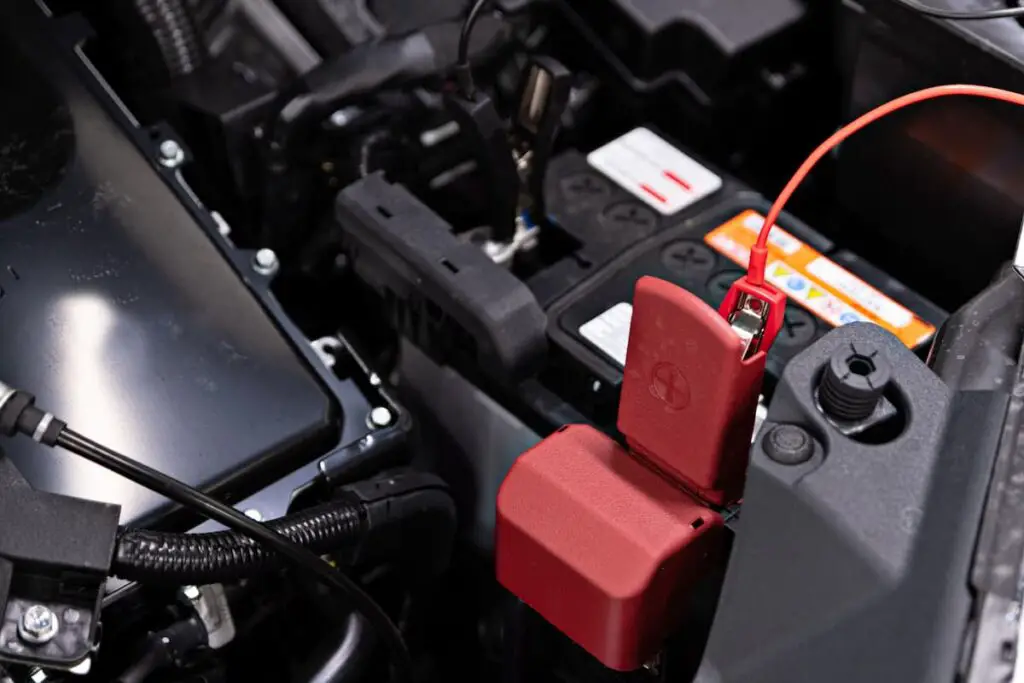
Take Safety Precautions When Jumpstarting the Car
While jumping a car in the rain may not be inherently more dangerous, it’s still important to exercise caution and take safety measures.
After all, you can never be too careful when working with electricity. Besides, just because the risk of electrocution is low, it doesn’t mean there aren’t other potential hazards.
Safety Measures When Jumpstarting a Car in the Rain
Having looked at the general safety of jumping a car in the rain, let’s now go over some specific measures you can take to stay safe while jumpstarting your vehicle.
Park the Car in a Safe Spot
First and foremost, make sure to park your car in a safe spot. Whether you’re jumping your car or changing the car battery in the rain, you’ll want to park on level ground and avoid puddles or standing water. Avoid stopping on hills or inclines, as well as any areas where there may be a risk of flooding. [Can You Change a Car Battery in the Rain]
Here are a few more tips for finding a safe spot:
- Look for well-lit areas, away from traffic or pedestrians: Working with jumper cables can be problematic in the dark, and it’s best to avoid any potential hazards, such as traffic or pedestrians passing by.
- Avoid parking too close to power lines: When jumpstarting your car in the rain, always be aware of your surroundings and keep a safe distance away from power lines or other potential hazards that could fall onto your vehicle.
Use Insulated Jumper Cables
If your car ever gets stranded with a dead battery, you’ll want to have a set of jumper cables on hand. But not just any cables will do – you’ll want to ensure you’re using insulated jumper cables. These cables have a layer of insulation that helps to isolate the electrical current, making them safe to use.
That’s in contrast to non-insulated cables, which pose a danger. Even if you’re careful, non-insulated cables can be tricky to handle, and it’s all too easy to accidentally cause sparks that may lead to a fire or electrocution.
That’s why it’s always best to err on the side of caution and use insulated jumper cables whenever you need a jump start. With insulated cables, you can rest assured that you’re taking all the necessary precautions to keep yourself safe.
I recommend these Energizer Jumper Cables for Car Battery from Amazon.com. They feature quality 6-gauge cables and are 4.8 meters (16 feet) long – perfect for jumpstarting your car in the rain. These cables also come with a carrying case for easy and compact storage.
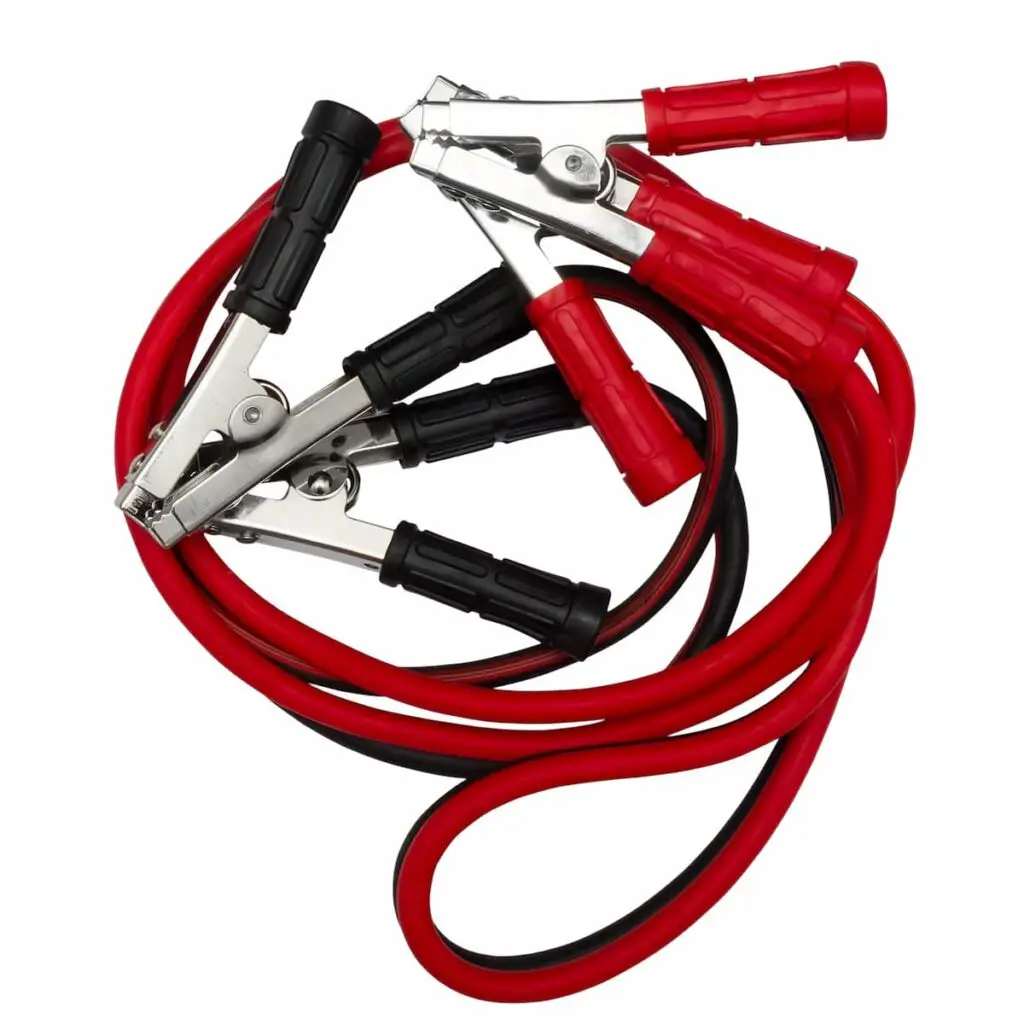
Make Sure Both Cars Are Off
Before beginning the jumpstarting process, turn off both cars’ engines and remove their keys. This will prevent any accidental movement or shifting that could lead to injury.
Besides, turning off both vehicles will also ensure that no additional electricity is flowing, making it safer to attach the jumper cables.
Keep Your Hands and Clothing Dry
As with any electrical work, it’s essential to keep your hands and clothing dry. Avoid handling the clamps or cables if you’re wet or standing in water.
If necessary, use a towel or dry cloth to wipe down the clamps and cables before handling them. And, of course, avoid touching any wet parts of the cars while connecting the cables.
Wear Protective Rubber Gloves and Shoes
When jumpstarting a car in rainy weather, it’s essential to protect yourself with appropriate gear.
Some of that gear includes the following:
- Rubber gloves: Rubber gloves will provide an extra layer of insulation and protect your hands from electrical shocks.
- Rubber-soled shoes: It’s essential to have a good grip while jumpstarting a car, and rubber soles can help prevent slipping in wet weather. They also provide additional insulation against electricity.
- Protective eyewear: Wearing protective eyewear, such as safety goggles, can help protect your eyes from potential hazards, including electrical sparks.
Cover the Battery and Cables With an Umbrella
If possible, shield the car’s battery and jumper cables from the rain with an umbrella or plastic sheet. This can help prevent any electrical shorts or malfunctions that could occur in wet weather conditions.
Just be careful not to block your view of the battery terminals while attaching the clamps, and make sure that the cover doesn’t get in the way or interfere with the process.
Ensure the Clamps Don’t Touch Each Other
When connecting the jumper cables to each car’s battery, be careful not to let the clamps touch each other or any metal surface. This can cause sparks and potentially result in injury or damage to the vehicle’s electrical system.
In addition, always connect the red clamp to the positive terminal and the black clamp to the negative terminal. Connecting them in reverse can damage the car’s electrical system.
How To Jump a Car in the Rain
Now that we’ve gone over the safety measures to take. Let’s go over the actual steps for jumpstarting a car in the rain:
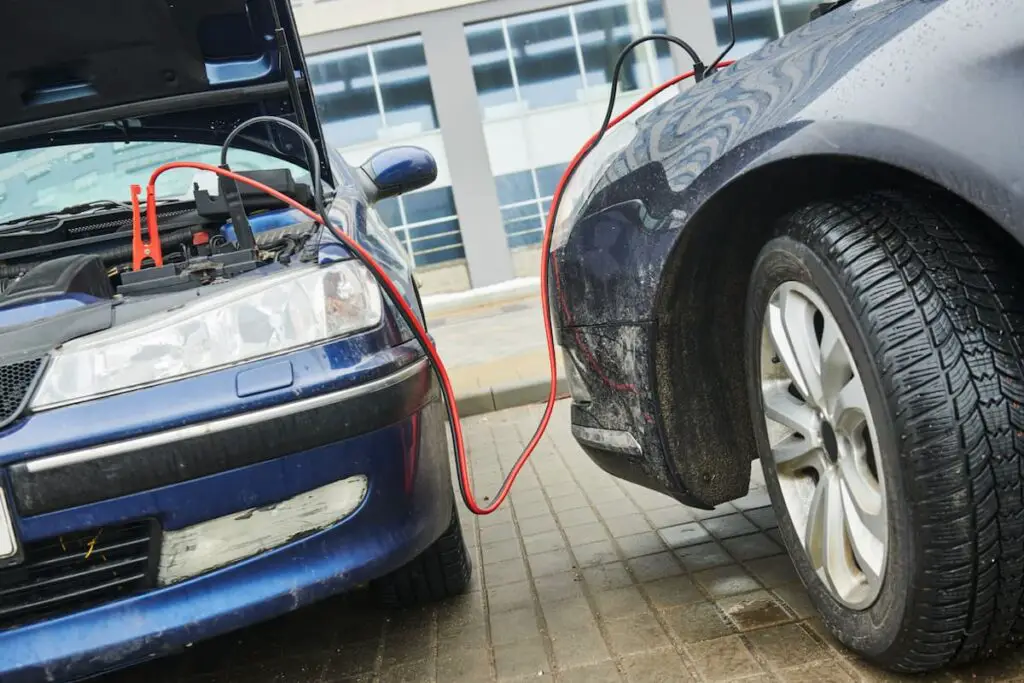
- Park both cars close enough so the jumper cables can reach both batteries, but do not let the vehicles touch. Turn off both cars’ engines and remove their keys.
- Put on rubber gloves, shoes, and any other protective gear.
- Inspect both cars’ batteries to ensure they have the same voltage. Ensure the batteries are also tightly secured and not leaking.
- Clean the battery terminals of both cars with a wire brush or towel if necessary.
- Attach one of the red clamps to the positive terminal of the dead car’s battery, and the other red clamp to the positive terminal of the working car’s battery.
- Attach one of the black clamps to the negative terminal of the working car’s battery, and then attach the remaining black clamp to a metal part of the dead car (such as a bolt) that is not near the battery.
- Start the working car, and let it run for a few minutes. Try starting the dead car. If it doesn’t start, let the functioning car run for a few more minutes before trying again.
- Once the dead car starts, remove the clamps in the reverse order you attached them.
The following YouTube video by ChrisFix provides a visual demonstration of these steps:
Note: Sometimes, you may not have another car nearby to jumpstart your vehicle. In that case, you can use a portable jumper battery to jumpstart your vehicle.
Using a portable jumper battery is generally similar to the above steps.
Here are a few key differences to keep in mind:
- Make sure the portable jumper battery has enough charge.
- Some portable jumper batteries have their own cables, while others may require you to use your car’s existing jumper cables.
- Follow any specific instructions provided with the portable jumper battery.
- When attaching the clamps, follow the markings for the positive and negative terminals.
The Possible Risks of Jumpstarting a Car in the Rain
Although jumpstarting a car in the rain is generally safe, there are still some potential risks to be aware of. Some of these include:
You May Have Electrical Sparks
As with any electrical system, there is a slight risk of sparks when jumpstarting a car. Sparks usually arise when the clamps are not correctly attached, or if they touch each other or the negative terminal of the dead car’s battery.
To prevent sparks, follow the proper steps for attaching the clamps and take extra caution in wet weather conditions.
You Could Damage Your Car’s Electrical System
If the clamps are connected in reverse, or if you jumpstart a car with too high voltage, it can damage the car’s electrical system. Specifically, it can damage the car’s alternator or fuse box.
Here are more parts that may be damaged if the jumpstarting process is not done correctly:
- Starter motor
- Sensors
- Ignition switch
To avoid this risk, properly follow the steps for jumpstarting a car, and only jumpstart a vehicle with the same voltage. If you are unsure about any aspect of the process, it’s best to seek the help of a professional.
Your Car May Not Start
In some cases, jumpstarting a car may not successfully start it. This could be due to various reasons, such as:
- A damaged battery: Jumpstarting may not work if the battery is too damaged or old (most batteries last between 36 to 60 months).
- A faulty engine: Jumping can only address a dead battery, not issues with the car’s engine.
- A faulty starter: Jumping may not work if the car’s starter is defective.
What To Do if You Can’t Jumpstart Your Car
If your car still doesn’t start after attempting to jumpstart it, there may be another issue with your car’s engine or electrical system.
Here are a few steps to take:
- Have the battery and electrical system checked by a professional. They may be able to diagnose and fix any issues.
- If necessary, consider replacing the battery or other faulty parts.
- If the car’s engine has an issue, have it looked at by a professional mechanic. They can determine if there are any repairs or replacements needed. In some cases, it may be more cost-effective to consider buying a new car rather than investing in repairs for an older car.
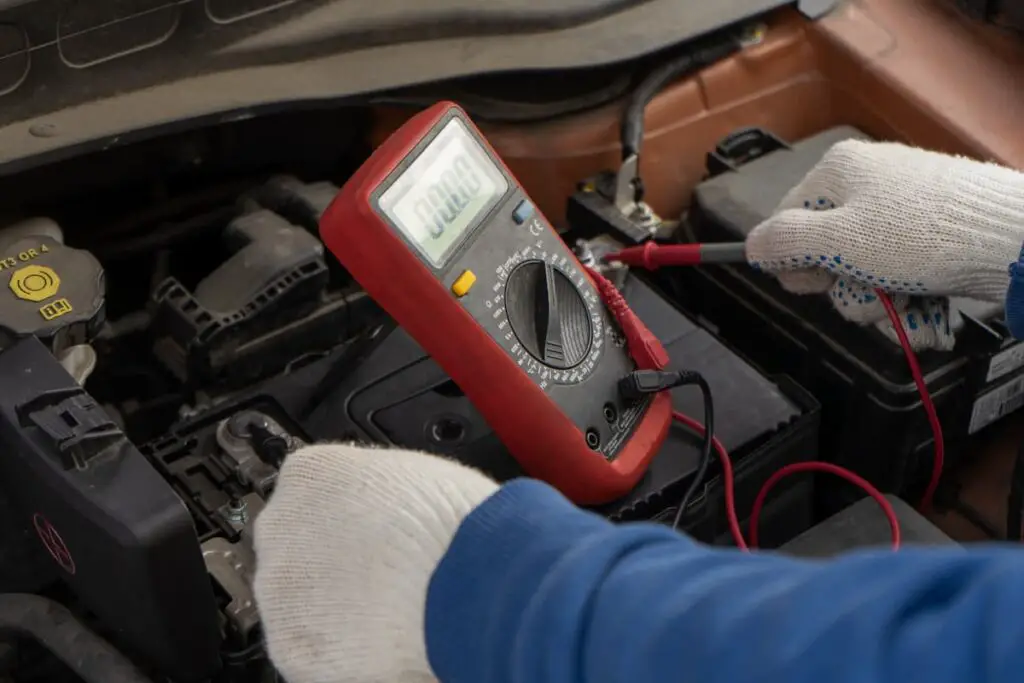
Final Thoughts
Overall, jumping a car in the rain is typically safe as long as proper safety measures are taken and the process is done correctly. However, if you are unsure about any aspect of the process or encounter any issues, it’s best to seek the help of a professional.
And if your car still won’t start after jumpstarting, there may be other underlying issues that require the assistance of a mechanic. Ensure to get any necessary repairs or replacements done to ensure your car’s safety and proper functioning.
